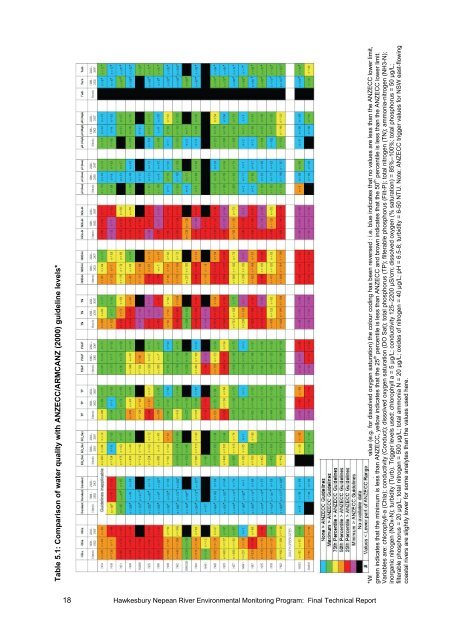Hawkesbury-Nepean River Environmental Monitoring Program
Hawkesbury-Nepean River Environmental Monitoring Program
Hawkesbury-Nepean River Environmental Monitoring Program
Create successful ePaper yourself
Turn your PDF publications into a flip-book with our unique Google optimized e-Paper software.
Table 5.1: Comparison of water quality with ANZECC/ARMCANZ (2000) guideline levels*<br />
18 <strong>Hawkesbury</strong> <strong>Nepean</strong> <strong>River</strong> <strong>Environmental</strong> <strong>Monitoring</strong> <strong>Program</strong>: Final Technical Report<br />
*Where the ANZECC Guidelines specify a low value (e.g. for dissolved oxygen saturation) the colour coding has been reversed : i.e. blue indicates that no values are less than the ANZECC lower limit,<br />
green indicates that the minimum is less than ANZECC, yellow indicates that the 25 th percentile is less than ANZECC and brown indicates that the 50 th percentile is less than the ANZECC lower limit.<br />
Variables are: chlorophyll-a (Chla); conductivity (Conduct); dissolved oxygen saturation (DO Sat); total phosphorus (TP); filterable phosphorus (Filt-P); total nitrogen (TN); ammonia-nitrogen (NH3-N);<br />
inorganic nitrogen (NOx-N); turbidity (Turb). Trigger levels used: chlorophyll a = 5 µg/L; conductivity 125–2200 µS/cm; dissolved oxygen (% saturation) = 85%–100%; total phosphorus = 50 µg/L;<br />
filterable phosphorus = 20 µg/L; total nitrogen = 500 µg/L; total ammonia N = 20 µg/L; oxides of nitrogen = 40 µg/L; pH = 6.5-8; turbidity = 6-50 NTU. Note: ANZECC trigger values for NSW east-flowing<br />
coastal rivers are slightly lower for some analytes than the values used here.
















